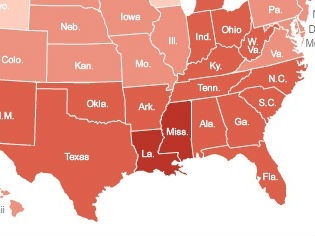The South's economic crisis

In 1938, with the U.S. still doggedly fighting to escape the Great Depression, FDR's administration declared the Southern region to be "America's Economic Problem Number 1." Although the country as a whole was struggling, the pain was most acutely felt in the South, which lagged by almost every economic measure: jobs, wage levels, family income and more.
Many of the reasons Roosevelt's experts gave for the South's dismal situation were specific to the era, like being "crushed" in the Civil War, the "vicious period" of Reconstruction and tariffs on cotton and tobacco. The way railroads were set up and subsidized in the late 1800s was still conferring a big advantage to Northern businesses.
Today, with Southern states among the nation's leaders in population growth and an influx of new industries, it's assumed the region has left its "Economic Problem Number 1" status behind. Skyrocketing unemployment in the Rust Belt and Western states like Nevada show other regions face just as daunting problems.
But in many ways, the South remains one of the nation's most troubled regions. While in the past, many Southern states have had chronically high poverty rates and low median incomes, the infusion of new industries -- from other parts of the country as well as overseas -- tended to keep unemployment low.
Today, many Southern states are experiencing the double whammy of high jobless rates AND high poverty, keeping millions in a state of economic insecurity.
Here's a chart looking at where Southern states stand today, using the more recent unemployment figures (which understate the full state of un- and under-employment) as well as number of people living below the poverty line:

As Bloomberg recently reported, the combination of joblessness and poverty points to a breakdown in the economic strategy favored by many Southern states, which for years promised union-free workplaces to lure industry. That brought jobs, but they didn't pay well, leading to high poverty rates.
But today, the jobs aren't even coming, adding unemployment to the list of economic woes.
The Bloomberg reporters went to upstate South Carolina, where a BMW plant brought in the early 1990s -- thanks to generous tax incentives and promises of keeping the plant union-free -- was supposed to usher in an era of economic salvation. But the low road of economic development ended up falling short:
Today, South Carolina is one of the most impoverished states in the nation, becoming the seventh poorest in 2010 from 11th in 2007, according to recent U.S. Census data. Its percentage of residents living in poverty shot to 18.2 percent from 15 percent in that period. In downtown Spartanburg, near- empty Morgan Square features a used clothing store and two pawn shops.
South Carolina and other southern U.S. states topped the nation’s poverty rankings, a sign of trouble in the so-called New South known for its growth and ability to lure employers with laws restricting union organizing. The South was the country’s only region with an increase from 2009 to 2010 in both the number of poor and their proportion of the population, the census said.
If Southern states continue to struggle with both lack of jobs and low-paying jobs, the Great Recession may mark the end-point of the South's low-road strategy.
Tags
Chris Kromm
Chris Kromm is executive director of the Institute for Southern Studies and publisher of the Institute's online magazine, Facing South.
